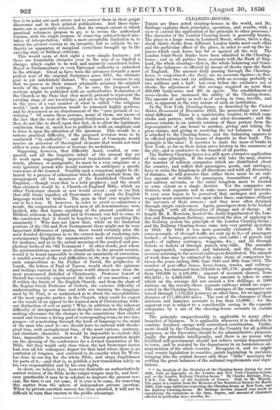CLEARING-HOUSES.
THERE are three noted clearing-houses in the world, and Mr. Babbage explains their principles, operation, and results, with a view to extend the application of the principle to other processes.* The character of the London Clearing-house is generally known. The place is a large room in Lombard Street, where, twice a day, about thirty clerks from different London banks meet each other and the particular officer of the place, in order to cast up the ba- lances which each house has for or against all the rest. The London Joint-Stock Banks have been admitted to the Clearing- house ; and as all parties have accounts with the Bank of Eng- land, the whole clearing—that is, the whole balancing and trans- fer of the balances—is effected by means of checks upon the Bank of England. The amount daily passing through the Clearing- house is conjectured—for there are no accurate figures—to flue- tuate between two and six millions, with an average probably of two millions and a half: but even before the exclusive use of checks the adjustment of this average required no more than 200,000 bank-notes and 20/. in specie. The establishment of cross-checks has increased the utility of the Clearing-house. The amount of safety as well as of saving in time, trouble, and cost, is apparent in the very nature of such an institution. In the New York Clearing-house, as described by the United States Economist of December 1855, the proceedings are some- what different. There is a semicircular counter, to which come clerks and porters, with checks and other documents ; and the process consists in an orderly rotation of these porters from the representative of one house to another, giving and taking the gross claims, and giving or receiving the net balances. A bank is attached to the Clearing-house, and the balancing appears to be effected principally by means of deposits in that bank. The principle is the same : it operates to unite the mass of banks in New York, so far as their union saves friction in the commerce of the city, and is conducive to the benefit of all parties.
The Railway Clearing-house is a still more extensive application
of the same principle. If the reader will take the map, observe the number of railway, companies which are distributed about the country, and reflect that passengers, goods, and carriages, have to cross the kingdom in all directions and with all diversities of distance, he will perceive that either there must be an end- less amount of trouble for passengers, transmitters of goods, and railway servants, or the entire kingdom must be treated to sonic extent as a single district. Yet the companies are distinct, with separate and in some cases antagonistic interests. It very soon began to be perceived that carriages and goods- waggons must sometimes run upon other lines, sometimes without the servants of their owners ; and they were often detained through simple carelessness. Again, passengers were to be booked " through " with all diversities of change and of charge. At length Mr. K. Morrison head of the Audit department of the Lon- don and Birmingham Railway, conceived the idea of applying to the Railway system the principle of the London Clearing-house ; and the Railway Clearing-house came into very partial operation in 1842. By 1845 it was more generally extended. All the cross-accounts of through traffic are sent up to it,—of passengers booked ; of horses, private carriages, and cattle ; of parcels and goods ; of railway carriages, waggons, 8.7.c. • and all through tickets or tickets of through parcels way-bills. The accounts are aggregated, compared, and balanced, and the charge or revenue accruing to the several railways is distributed. The amount of work done may be estimated by some items of comparison be- tween the years ending 30th June 1845 and 30th June 1855. The number of post-office boxes, horse-boxes, trucks, and railway- carriages, has increased from 219,658 to 987,178; goods-waggons, from 180,606 to 4,101,066; amount of accounts cleared, from 401,6514, to 4,829,649/. This large amount is taken in sums which on the average did not exceed a few shillings, at 2500 stations on the seventy-three separate railways which are repre- sented in the Clearing-house. The carriages of the companies are traced through 7,179,212 journeys on other lines, for an aggregate distance of 177,395,216 miles. The cost of the clearance of these intricate and immense accounts is less than 13,000/. • for the apparent cost is subject to a considerable saving to the separate companies by a use of the clearing-house servants in certain cases.
The principle unquestionably is applicable to many other branches of business. It is applicable wherever it is desirable to combine localized energy with centralized coordination. Parlia- ment should be the Clearing-house of the Country for all political purposes, as the Executive should be for administrative purposes. Apply the principle intelligently, and there is no reason why localized self-government should_ not relieve certain departments in town, and be assisted by the department in an harmonious ad- ministration of the whole country. Recognize it, and we might send county legislation to counties, parish legislation to parishes, bringing into the central houses only those " bills " necessary for settling the great balances of the national requirements and regu- lations.
• "An Analysis of the Statistics of the Clearing-house during the year 1839, with an Appendix on the London and New York Clearing-houses, and on the London Railway Clearing-house." By Charles Babbage, Esq., F.R.8., Cor. Memb. of the Institute of France. Sold by Mr. Murray. The paper is a reprint from the Memoirs of the Statistical Society for March 1866, with some additions respecting the Clearing-house at New York, and the Railway Clearing-house. Mr. Babbage devotes himself very much to considering the variations in the time, degree, and amount of clearances effected in particular days, months, &c.


























 Previous page
Previous page